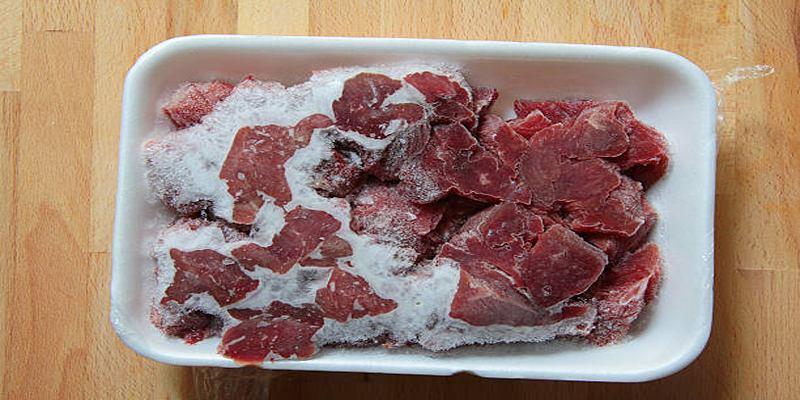Mastering Meat Freezing: Guide and Longevity Tips
Mar 02, 2024 By Madison Evans
Freezing meat is a practical way to extend its shelf life and preserve its quality, making it a go-to method for many households aiming for cost-efficiency and convenience in meal preparation. This comprehensive guide is designed to give you a solid understanding of freezing fundamentals while offering advanced strategies for maintaining flavor and safety in long-term meat storage. Whether you're a seasoned home chef or a beginner in kitchen management, our tips and step-by-step instructions will ensure you master the art of meat freezing.
Basics of Freezing Meat
 Freezing meat slows down spoilage by transforming residual moisture into ice, thereby inhibiting bacterial growth that could lead to foodborne illnesses. To maintain the quality, it's crucial to freeze meat at 0°F as quickly as possible. The faster the freezing process, the smaller the ice crystals that form, which means less damage to the muscle fibers and better texture upon thawing.
Freezing meat slows down spoilage by transforming residual moisture into ice, thereby inhibiting bacterial growth that could lead to foodborne illnesses. To maintain the quality, it's crucial to freeze meat at 0°F as quickly as possible. The faster the freezing process, the smaller the ice crystals that form, which means less damage to the muscle fibers and better texture upon thawing.
Selecting the Right Packaging for Meat Freezing
Choosing the correct packaging is vital for preventing freezer burn, which occurs when air reaches the meat's surface and dries it out, leading to a loss of quality and flavor. Ideal packaging is moisture-resistant and airtight, such as freezer bags, heavy-duty aluminum foil, or plastic wrap. Vacuum-sealed bags are preferred as they remove air exposure entirely, ensuring the meat stays fresher for a longer duration.
Methods for Freezing Various Types of Meat
Different meats require specific freezing techniques to best preserve their quality. For instance, ground meat should be pressed flat in a plastic bag to expel any air and quicken the freeze, thus preserving its texture and flavor. Steaks and chops are best frozen individually to make thawing easier, while whole cuts like roasts can be frozen in their original packaging if it's vacuum-sealed or overwrapped with an additional layer of protection.
Labelling and Organizing Your Freezer
Organization is key to managing your freezer's contents effectively. Always label your meats with the type, cut, weight, and freezing date to keep track of their longevity. Arrange the meats in your freezer according to the type and frequency of use, with those needing to be used sooner placed in more accessible spots. This way, you can avoid unnecessary waste and make the most of your frozen meats.
The subsequent sections will delve into preserving freshness and flavor, defrosting techniques, safety guidelines, and much more to empower you with the knowledge you need for optimal meat freezing practices. Let's get started!
Maximizing Meat Freshness and Flavor
To ensure the best quality upon thawing, it's essential to freeze meat when it is at its freshest. This means buying or cutting and packaging the meat immediately, as oxygen and temperature fluctuations can degrade the meat even before freezing. Avoid overloading your freezer with too much meat at once, which can increase the freeze time and potentially affect the meat's flavor.
Safety Considerations for Frozen Meat
Proper handling and storage of frozen meat are essential to prevent foodborne illnesses. Always thaw meat in the refrigerator or using approved methods such as microwaving or cold-water immersion. Refrain from refreezing previously frozen meat unless it's been thoroughly cooked. Additionally, ensure your freezer maintains a consistent temperature of 0°F to avoid any spoilage.
Strategies for Long-Term Meat Storage
For long-term storage, optimizing your freezer space and consistently monitoring freezer conditions are paramount for extending the shelf life of your meat. Here are the strategies you should follow:
- Regularly Check Freezer Temperature: Ensure your freezer is always at 0°F or below to keep the meat in a safe, frozen state.
- Rotate Stock: Use the FIFO (First In, First Out) method to cycle through older meat first and avoid freezer burn or spoilage.
- Avoid Partial Thawing: Keep your freezer full but not overcrowded to prevent fluctuations in temperature that can cause partial thawing and refreezing.
- Maintain a Freezer Inventory: Keep a log of everything in the freezer with dates and use reminders to keep track of when meat should be consumed.
Tips for Using Frozen Meat in Recipes
When incorporating frozen meat into recipes, understanding how to properly use it can make all the difference in the success of your dish. To capitalize on the convenience of having a stocked freezer without compromising on taste or safety, following these tips is crucial:
1. Before cooking with frozen meat, always ensure it is completely defrosted. This can be done in the refrigerator; while this method is slower, it is the safest way to maintain the meat’s quality. When planning your meals, remember to account for the required defrosting time.
2. For those instances when time is of the essence, it's possible to cook frozen meat directly without thawing. This typically requires an additional one-third of the cooking time used for fresh meat. However, do note that cooking meat from a frozen state might not be recommended for all recipes, especially those where an even cook is paramount, such as a perfectly medium-rare steak.
3. To minimize moisture loss, cook frozen meat on lower heat settings if you’re using a pan or the oven. In a slow cooker, the prolonged cooking time and retained moisture environment can be forgiving to frozen cuts, but always check for doneness with a meat thermometer to be certain it has reached a safe internal temperature.
4. Textures can also be affected when cooking from frozen. For instance, cuts that are typically seared, such as steaks or pork chops, might not have the same crust or caramelization. If your recipe calls for such a texture, you may be better off thawing the meat first.
Conclusion
Freezing meat is an excellent way to preserve its freshness and ensure it stays safe to eat for extended periods. By understanding the best practices for freezing, defrosting, and using frozen meat in recipes, you can make the most of your freezer space and enjoy delicious meals at any time. Remember to always prioritize safety by following proper food handling guidelines and monitoring your freezer's temperature regularly. Happy freezing! So, never compromise on the quality of your meat and follow these tips for maximum freshness and flavor. With proper handling and storage techniques, you can enjoy high-quality meat anytime without worrying about foodborne illnesses or wasted food.








